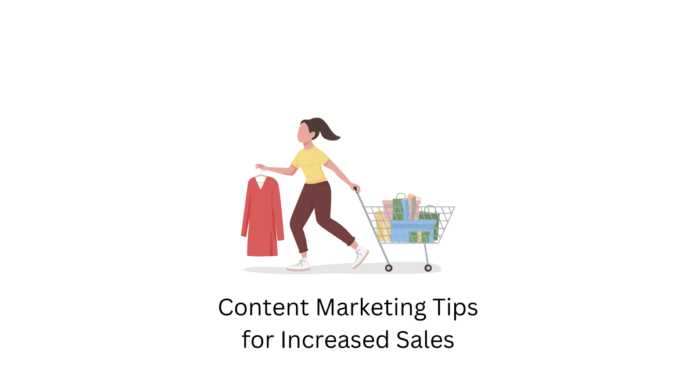Last updated - October 7, 2022
You will need to plan the customer’s journey and produce content that is appropriate for each stage of the journey if you want to transform prospects from interested parties into paying customers.
The key to designing a funnel that is effective is having a solid understanding of the many types of leads and the requirements of each one.
In point of fact, marketers fail to correctly identify their potential clients before moving them farther along the sales funnel, which results in the loss of 67% of all sales opportunities.
In this post, I will assist you in determining the three primary phases of the sales funnel and provide you with some suggestions regarding the kind of content you ought to adopt at each level in order to increase the number of sales you make.
Let’s get into action.
Creating a Map of the Customer Experience
The customer’s experience is broken down into its most basic components in the following graphic.


It is essential to keep in mind that the new customer experience is not conducted in a linear fashion, and that prospects might approach your channel at any moment.
Awareness Stage
Your potential customers are looking for a solution to a problem, an answer to a question, or a way to fulfill a need when they are in the awareness stage. Buyers are searching for information and resources at this phase since they have a limited awareness of the solutions they can do to satisfy that demand or address that problem.
They are not able to come to a decision regarding the kind of things they should buy in order to solve their issues because there are so many options.
At this point, the objective is to offer them the maximum amount of value up front as is practically possible by utilizing high-quality educational information that will point them in the direction of a solution.
Keep in mind that the use of high levels of sales pressure or strategies such as FOMO (fear of missing out) won’t be effective at this point in the sales funnel. Alternatively, you should be concentrating on cultivating prospects by giving them high-quality blog content, newsletters, and ebooks that you write yourself. Leads will be guided into the consideration stage when they encounter content of this type.
The Stage of Consideration
After passing through the awareness phase, a potential customer moves on to the consideration phase. You have succeeded up to this point in capturing the attention of a potential customer, and they are now curious about the products and services that your business provides. However, they are now engaged in the process of evaluation and are not yet ready to buy. Bear in mind that in this particular stage, leads are searching for the most effective answer to the problem that they are experiencing.
At the very top of the sales funnel, you should be prospecting with high-quality educational content. At this point in the process, you need to demonstrate to the client why your services or goods are the best answers to their problems.
At this stage, your objective is to paint a mental picture for your potential customers of what their lives would be like if they accepted your recommendations for resolving their issues. Maintain your concentration on the returns they can anticipate receiving and the benefits they will have if they choose to engage in your services.
Offer them free trials, savings, and videos as a method to ease them into the next stage of the funnel. This is a good strategy to move them along more quickly. Due of the low level of investment required from the lead during this phase, extended involvement is required. Establishing trust between your brand and your prospects is essential because they have not yet committed to doing business with you.
Purchase Stage
Following the extensive period during which you nurtured your leads farther down the funnel, they have finally reached the point where they are prepared to make the decision to make a purchase. However, this does not in any way guarantee that they will go with the answers that you propose. This is the ultimate decision that needs to be made by a lead: What is the most effective answer to the challenge they face?
In most cases, customers at the bottom of the funnel are ready to make a purchase, and all it takes is one great call-to-action to convince them to buy your goods. At this point in the process, the call-to-action, incentive, and type of information that you employ will have a significant influence on the number of conversions you receive.
Nevertheless, the purpose of this stage is not simply to press leads to purchase a product at this point. You should also supply them with educational resources on how to implement the creative approach into their lives. You will demonstrate that you concern about their success when using your services and products if you act in this manner.
Ideas for Content to Be Used at Each Stage of the Funnel
Pymnts reports that prior to making a purchase, 88 percent of consumers conduct research about their potential purchases online. The odds are that your leads also fall into that category.
Bear in mind that at this moment in time individuals are in the stage of information collecting, and it is quite probable that the services or products that will capture their interest will be the one that was generated by a company that produces high-quality content.
This content must to not just be educational, but also entertaining and engaging.
Investing in focused high-value content like the following can help you get the attention of leads at this stage:
- Blog posts.
- eBooks.
- Documents.
At this juncture, we also place a great value on innovative and independent research.
However, you shouldn’t limit yourself to merely the textual content. You are going to require infographics, films, and content for social media if you want to differentiate yourself in a competitive industry.
Ideas for Content to be Contemplated During the Next Stage
When prospects have reached the center of the funnel, it is time for them to begin analyzing and discarding potential solutions. Therefore, although producing content of a high quality will draw leads at the top of the funnel, this kind of material does not have the power to nurture leads further down the funnel.
A recent survey indicated that a surprising number of businesses who sell to other businesses (B2B) have not defined their sales funnel. You won’t be able to detect where potential customers are in the purchase process if you don’t have a sales funnel that’s well defined. This indicates that there is no possible way for you to nurture prospects and advance them farther down the sales funnel.
At this stage, leads are looking for industry experts, and in order to show them that you are one of those experts, you will need to provide them with material that is interesting and engaging.
The following categories of material are currently proving to be the most successful:
- Webinars.
- Expert guides.
Live conversations that demonstrate the value of your products or services.
It is also vital to measure clicks in your email marketing efforts and observe which postings on social networks enhance interaction in order to gain a better understanding of the types of services your prospects are looking for.
As was just pointed out, it is critical that you establish oneself as an authority on the subject matter at this point in time. However, in order to properly nurture leads through the funnel, you need an expert who is helpful. Even though these leads have not yet reached the point where they are prepared to make a buy, you still need to answer their inquiries and provide extra details.
According to the findings of a recent study, 65 percent of B2B marketers have not implemented lead nurturing. It is imperative that you steer clear of making this error and instead establish yourself as a reliable advisor.
Market2Lead conducted an analysis of the data provided by their customers and compared nurtured leads to non-nurtured leads. They discovered that the sales cycle for nurtured leads is 23 percent shorter.
Ideas for Content During the Process of Purchasing
You can locate information that is appropriate for the purchasing stage all over the internet if you conduct an analysis of the sort of marketing content that is the most prevalent type of content. Despite the reality that now the majority of leads are not even near to ready to make a purchase, websites are bursting to the seams with calls-to-action, freebies, samples, and trial offer opportunities.
In point of fact, the research conducted by Marketing Sherpa revealed that 61% of B2B marketers push all leads directly to sales, despite the fact that only 27% of those leads will be recognized. It is essential that you are aware of the fact that it is extremely improbable that the material at the bottom of the funnel would convert a prospect into a customer. It is necessary for you to produce appropriate content for the entire buyer’s journey.
Only by mapping your content in an appropriate manner to the buyer’s journey will you be able to build an offer that is engaging to potential customers. This indicates that your content should progress in a manner that is appropriate for each level.
The following categories of material tend to be the most successful in the final stage:
- Demos.
- Deals and discounts.
- Case studies.
- Product implementation.











